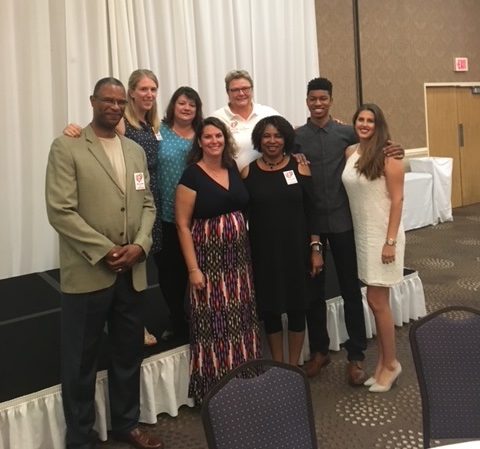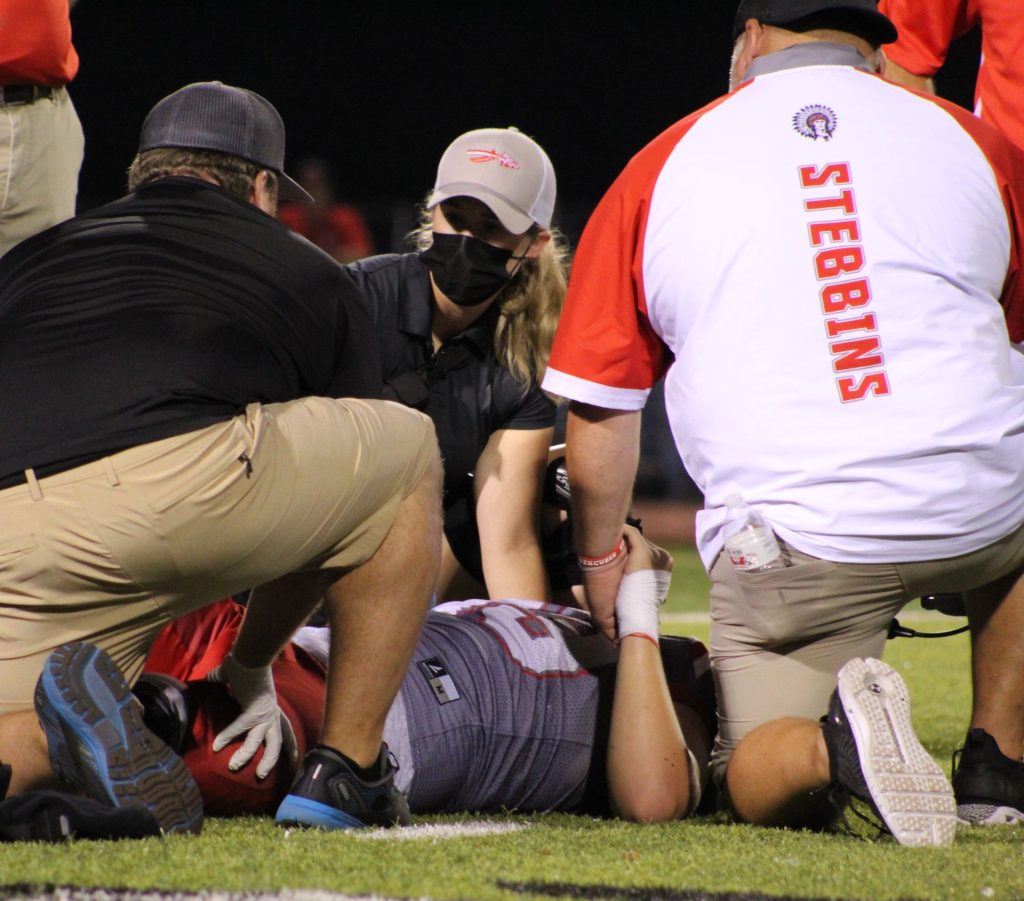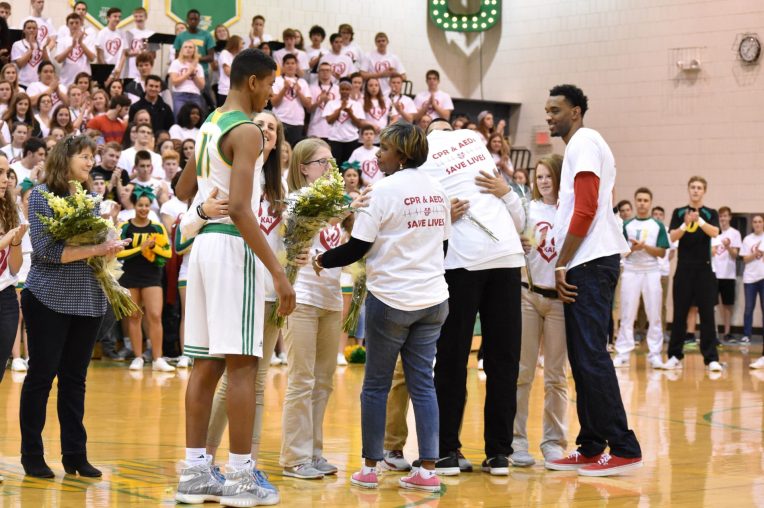When Buffalo Bills safety Damar Hamlin collapsed on the field during a Monday Night Football game on January 2, it became perhaps the most-witnessed cardiac event in human history. If you weren’t watching live, you likely heard about it the next day.
After making a seemingly routine tackle, Hamlin stood briefly before falling to the ground. Medical personnel rushed onto the field. Athletic trainers delivered cardiopulmonary resuscitation (CPR) and deployed an automated external defibrillator (AED) before Hamlin was transported via ambulance to a local hospital.
Hamlin had suffered commotio cordis, a rare instance of a person’s heart rhythm being disrupted by a blow to the chest that—if untreated within 3 minutes—has a 97% death rate. The quick reactions of athletic trainers saved Hamlin’s life.
The first week of June is CPR and AED Awareness Week. But it came—unofficially—early this year. Hamlin’s near-death experience and subsequent recovery underscored the importance of emergency action plans, and CPR and AED training.
It’s a truth well known by some members of the Illinois State community.
February 9, 2017
On a February afternoon in 2017, Illinois State University graduate student athletic trainers Maddie Biehl, M.S. ’17, and Emily Martz, M.S. ’18, readied for a busy slate of practices and games in the University High School athletic training office.
An ordinary day turned into anything but when a frantic boys’ basketball player appeared in the office doorway. “It’s Kai,” he said.
Biehl and Martz sprinted to the gym to find Kai Bates-Diop lying unresponsive on the court without a pulse. Within seconds, Biehl and Martz enacted their emergency action plan. Biehl began CPR. Martz retrieved an AED and called 911. Biehl delivered two-and-a-half cycles of CPR before a shock from the AED restored Bates-Diop’s heartbeat. Biehl and Martz kept him calm and monitored the high school sophomore until paramedics arrived.
Bates-Diop was taken to a local hospital and later life-flighted to a Peoria hospital. He was diagnosed with hypertrophic cardiomyopathy. His once-promising basketball career was over.

But his life was saved.
“It was the fact that we were able and ready. We were prepared,” said Martz, now an athletic trainer with Kettering Health in Dayton, Ohio. “Seconds can make a difference in that kind of situation.”
Delivering immediate care to Bates-Diop had a profound impact on Martz and Biehl, both just 23 years old at the time.
“It was a life-changing day for me,” said Biehl, now the head athletic trainer at the University of Northern Colorado. “As uncomfortable as it is for athletic trainers to be in the spotlight, it was really good for our profession, shining a light on AED and CPR awareness and how important our job is.”
Making a difference
More than 350,000 cardiac arrests occur in the United States each year outside hospital settings. Providing immediate care like delivering CPR or deploying an AED significantly increases a person’s survival chances, but only about 40% of those people get care before professional help arrives.
Awareness statistics are even more troubling. Most Americans can’t get first aid or CPR/AED training from their employer, and half of all Americans cannot locate an AED at their place of work.
Get certified at Illinois State University
Environmental Health and Safety offers the American Heart Association Heartsaver and Basic Life Support CPR/AED training to university employees and students at a cost of $25 per attendee. Comparable courses open to public in the community cost approximately $100-125. Upon completion of course requirements, participants receive a certification card valid for two years. Students and staff can sign up for training at the Environmental Health and Safety website. Requests for private group CPR and AED training can be directed to Adam Streenz.
The Bates family aims to change that. Since Kai Bates-Diop’s cardiac arrest, the entire family has become dedicated to raising awareness.

“The presence of an AED and Emily and Maddie knowing what to do, that’s what gave Kai the chance he needed,” said Wilma Bates, Kai’s mother and a director of development at Illinois State.
Kai Bates-Diop and his brother Keita Bates-Diop host an annual basketball camp at U-High. Proceeds have been used to purchase AEDs for local community centers, schools, and youth sports facilities. They’ve given away a dozen or so since the camp began.
Keita has further used his platform—a graduate of U-High and Ohio State University, he is currently a member of the NBA’s San Antonio Spurs—to raise awareness. He was recognized in February for his efforts with the NBA Cares Community Assist Award.
“The Bates family and the Bates-Diop brothers are some of the best people I’ve ever met,” Biehl said. “What they’re doing for AED and CPR awareness is really important work.”
Always ready
John Munn has been an athletic trainer at Illinois State since 1992. He’s been the head athletic trainer for Redbird men’s basketball since 1994. He’s never had to deploy an AED.

“I only know a handful of athletic trainers who have done it once,” said Munn, who has overseen hundreds of athletic trainers during his tenure. “Emily is the only person I can think of who’s had to do it twice.”
That’s right. This spring, Martz deployed an AED for the second time during her young career. During a track practice at Stebbins High School in Dayton this March, a student-athlete came into the trainer’s office feeling sick. The student promptly collapsed into Martz’s arms.
Drawing upon her training—and an eerily similar experience six years prior—Martz snapped into action. A fellow trainer started CPR and Martz readied an AED. After receiving a shock, the student’s heartbeat was restored before paramedics arrived.
The student survived and received a heart transplant two weeks later. She was discharged from the hospital the day before her high school graduation.
“You never want those moments to happen,” Martz said. “But we are always ready for them.”
You won’t regret it
Congressional legislation to promote access to AEDs in elementary and secondary schools was introduced in March.
AEDs at ISU
Environmental Health and Safety manages Illinois State’s AED program. Currently, there are 144 AEDs present in university facilities (not including ISU Police vehicles, each of which are equipped with AEDs). Campus AEDs are placed in visible and accessible areas to provide a targeted response time of 3 minutes from leaving and returning to the scene of an emergency. A map of AED locations is available in the Safe Redbirds App, available for free at the Apple App Store or Google Play.
As part of the rollout, Damar Hamlin visited the White House to share his experience and advocate on behalf of the bill. Kai Bates-Diop was there, too.
“It was very emotional, but Kai was proud to go and share with people that this is what life can look like afterward,” Wilma Bates said.
While Kai leads the awareness charge, he’s not alone. He and his family have kept in touch with Martz and Biehl over the years. They consider each other family now. Phone calls and text messages are regular. Gifts are exchanged on birthdays and holidays. Graduations and weddings are celebrated. Kai was recently a groomsman in Biehl’s wedding.
Forever connected through a traumatic event with a happy ending, the group collectively advocates for CPR and AED awareness. Their advice is simple: Locate the AEDs in the places you spend the most time and take a CPR or AED certification course.
The investment of a few moments of your time may make all the difference in the world to someone else.
“You’re never going to regret being CPR or AED certified,” Biehl said. “It doesn’t take much skill, and it doesn’t take much time, but it could change someone’s life.
“It could save someone’s life.”

